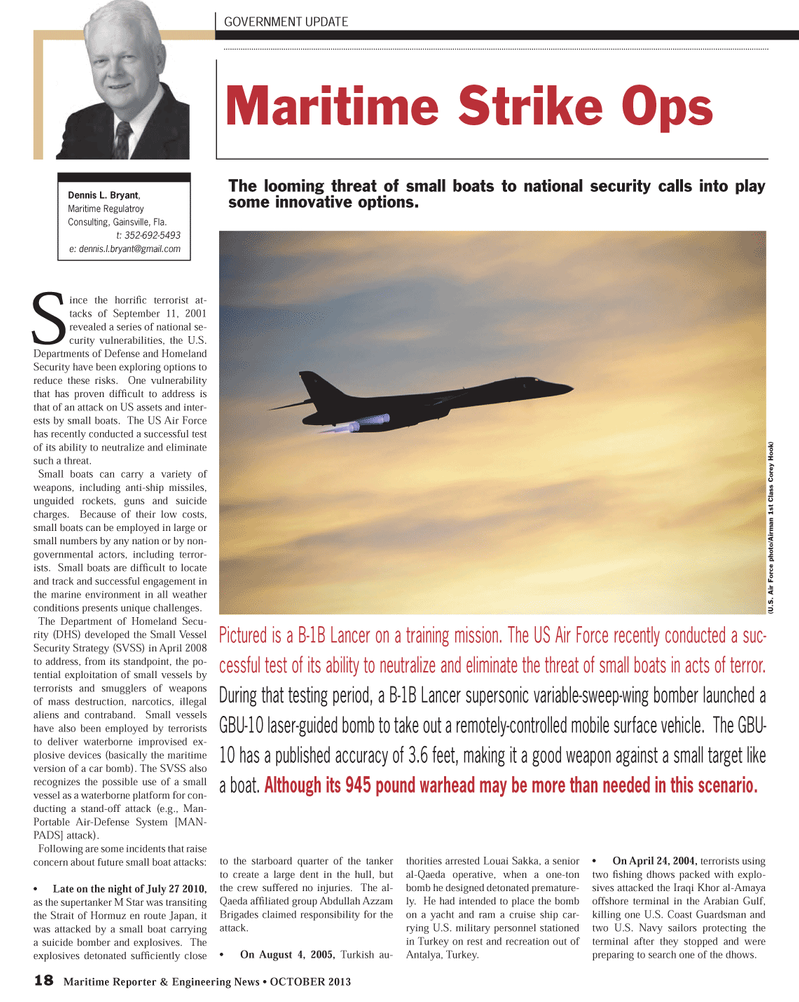
Page 18: of Maritime Reporter Magazine (October 2013)
Marine Design & Construction
Read this page in Pdf, Flash or Html5 edition of October 2013 Maritime Reporter Magazine
18 Maritime Reporter & Engineering News ? OCTOBER 2013 Since the horriÞ c terrorist at- tacks of September 11, 2001 revealed a series of national se-curity vulnerabilities, the U.S. Departments of Defense and Homeland Security have been exploring options to reduce these risks. One vulnerability that has proven difÞ cult to address is that of an attack on US assets and inter- ests by small boats. The US Air Force has recently conducted a successful test of its ability to neutralize and eliminate such a threat.Small boats can carry a variety of weapons, including anti-ship missiles, unguided rockets, guns and suicide charges. Because of their low costs, small boats can be employed in large or small numbers by any nation or by non-governmental actors, including terror- ists. Small boats are difÞ cult to locate and track and successful engagement in the marine environment in all weather conditions presents unique challenges.The Department of Homeland Secu-rity (DHS) developed the Small Vessel Security Strategy (SVSS) in April 2008 to address, from its standpoint, the po-tential exploitation of small vessels by terrorists and smugglers of weapons of mass destruction, narcotics, illegal aliens and contraband. Small vessels have also been employed by terrorists to deliver waterborne improvised ex-plosive devices (basically the maritime version of a car bomb). The SVSS also recognizes the possible use of a small vessel as a waterborne platform for con-ducting a stand-off attack (e.g., Man- Portable Air-Defense System [MAN- PADS] attack). Following are some incidents that raise concern about future small boat attacks:? Late on the night of July 27 2010, as the supertanker M Star was transiting the Strait of Hormuz en route Japan, it was attacked by a small boat carrying a suicide bomber and explosives. The explosives detonated sufÞ ciently close to the starboard quarter of the tanker to create a large dent in the hull, but the crew suffered no injuries. The al- Qaeda afÞ liated group Abdullah Azzam Brigades claimed responsibility for the attack.? On August 4, 2005, Turkish au-thorities arrested Louai Sakka, a senior al-Qaeda operative, when a one-ton bomb he designed detonated premature-ly. He had intended to place the bomb on a yacht and ram a cruise ship car- rying U.S. military personnel stationed in Turkey on rest and recreation out of Antalya, Turkey. ? On April 24, 2004, terrorists using two Þ shing dhows packed with explo- sives attacked the Iraqi Khor al-Amaya offshore terminal in the Arabian Gulf, killing one U.S. Coast Guardsman and two U.S. Navy sailors protecting the terminal after they stopped and were preparing to search one of the dhows.GOVERNMENT UPDATE Maritime Strike OpsThe looming threat of small boats to national security calls into play some innovative options.Dennis L. Bryant, Maritime Regulatroy Consulting, Gainsville, Fla.t: 352-692-5493e: [email protected] is a B-1B Lancer on a training mission. The US Air Force recently conducted a suc- cessful test of its ability to neutralize and eliminate the threat of small boats in acts of terror. During that testing period, a B-1B Lancer supersonic variable-sweep-wing bomber launched a GBU-10 laser-guided bomb to take out a remotely-controlled mobile surface vehicle. The GBU- 10 has a published accuracy of 3.6 feet, making it a good weapon against a small target like a boat. Although its 945 pound warhead may be more than needed in this scenario. (U.S. Air Force photo/Airman 1st Class Corey Hook) MR #10 (18-25).indd 18MR #10 (18-25).indd 1810/2/2013 3:47:25 PM10/2/2013 3:47:25 PM

 17
17

 19
19
